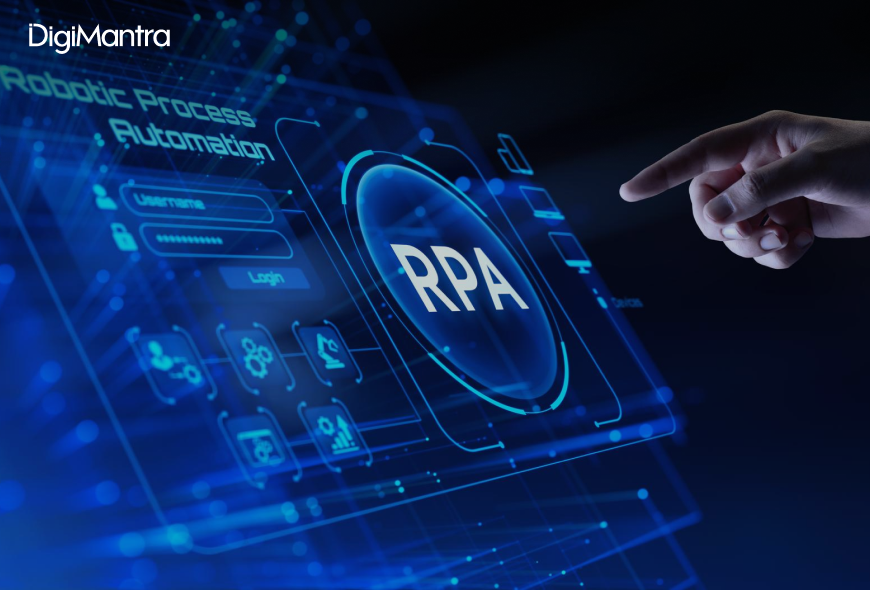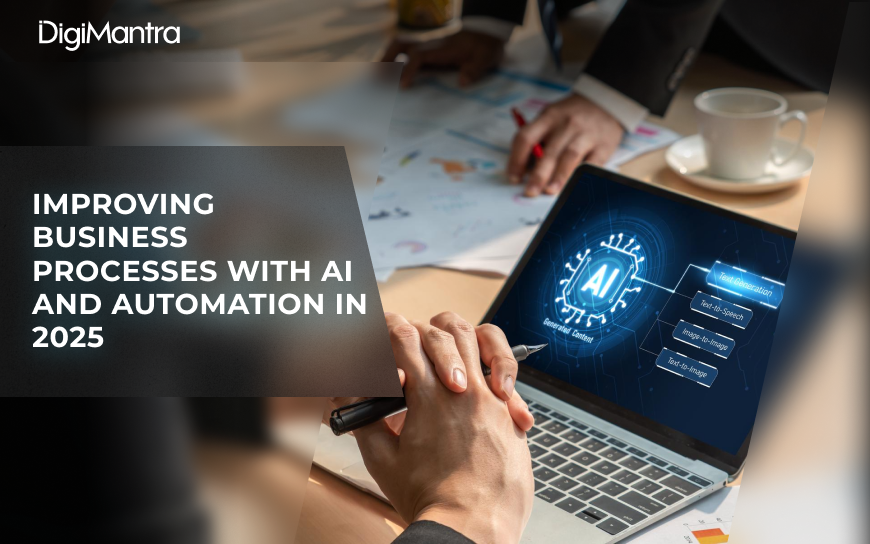In the fast-changing business environment of today, organizations are turning more and more towards technology solutions to automate processes, cut costs, and achieve a competitive edge. Of all the solutions available, artificial intelligence automation and robotic process automation (RPA) are revolutionizing the way businesses are run. This detailed guide discusses how AI and automation are changing the face of business processes in any industry.
Understanding AI Automation: Definition and Functionality
What is AI automation, really? It's the application of artificial intelligence technologies to automate complex tasks that have historically relied on human intellectual abilities. Unlike traditional rule-based automation, AI automation applies machine learning, natural language processing, and pattern recognition to execute complex, changing tasks with minimal or no human intervention.
Artificial intelligence automation is transforming the way that companies manage routine tasks and bringing cognitive functions into decision-making. The computers can process large volumes of data, recognize patterns, and make informed decisions based on the data they are processing. The technology keeps improving, and capabilities are expanding beyond mere task automation to advanced decision-making support.
According to Precedence Research reports, the hyperautomation industry in the United States was 14.14 billion dollars during the 2024 timeframe and is expected to expand to 69.64 billion dollars around the year 2034, with the 17.28% CAGR through effective AI and automation services. The escalating rise is indicative of the growing acknowledgment of the worth of AI automation in business processes.

Automation and AI: Comprehending the Underlying Relationship
The dynamics between automation and AI are further developing as technology advances and new uses appear in various industries. While rule-based processes are the staple of classic automation, AI introduces cognitive abilities allowing systems to learn, change, and get better with time.
Automation AI solutions are increasingly available to companies of all sizes, not only to large enterprise-level organizations. The technology democratization is pushing AI and automation services adoption across industries:
- Finance: Transaction processing automation, suspicious activity monitoring, and customer support.
- Healthcare: Patient records management automation and diagnostic assistance.
- Manufacturing: Production line optimization and quality assurance.
- Retail: Inventory management automation and personalized customer experiences.
The numbers of adoption speak for themselves: Business AI adoption grew from 55% in 2023 to 72% in 2024, and 60% of the companies had implemented some automation solution in their processes.
Key Differences and Complementary Advantages of RPA and AI
RPA and AI have different roles but complement each other perfectly in business process improvement. Robotic Process Automation (RPA) is great at automating repetitive, rule-based processes by emulating human steps in electronic systems. It's best suited for structured data and well-defined operations.
AI and RPA together constitute an unstoppable duo designed to deal with structured as well as unstructured data processing issues. While RPA takes care of the mundane, repetitive activities, AI brings in the intelligence to deal with exceptions, make choices, and improve processes constantly through learning.
The intersection of RPA and artificial intelligence via AI software development services is opening up new avenues for process optimization between departments. The union allows:
- Intelligent document processing: Managing and capturing records from various styles of documents.
- Advanced analytics: Providing insights from process data.
- Cognitive decision-making: Managing exceptions based on patterns learned.
- Continuous improvement: Optimizing processes by themselves based on results.
Top RPA providers are now embedding AI features within their solutions to provide more holistic automation options. The market for RPA is set to hit $22 billion by 2025, a testament to the escalating need for such combined solutions.

AI for Business Automation: Implementation Strategies and Best Practices
When implementing AI for business automation, organizations should start with clearly defined processes that offer the highest potential ROI. A planned way of implementation includes:
1. Process Assessment and Selection
Begin by identifying processes that are:
- Repetitive and time-consuming.
- Rule-based with clear decision points.
- High-volume with significant manual effort.
- Prone to human error.
- Critical but not requiring complex human judgment.
2. Technology Selection
Choose the right set of technologies depending on your particular requirements:
- RPA for structured, rule-based processes.
- Machine learning for pattern discovery and prediction.
- Natural language processing for textual and conversational workflows optimization.
- Computer vision for image and document processing.
3. Pilot Implementation
Begin with a controlled pilot to:
- Verify the effectiveness of the technology.
- Pin down potential issues.
- Compute actual ROI.
- Develop internal skills.
- Establish stakeholder buy-in.
4. Scaling and Governance
 Put in system a robust governance structure for expanding automation:
- Set up a Center of Excellence (CoE).
- Establish standardized implementation methodologies.
- Install security and compliance procedures.
- Set performance metrics and monitoring.
- Organize for maintenance and updates.
Paving the way for an automated business process framework takes good planning and choosing the right technologies for your particular requirements. Companies that observe these best practices normally attain greater success rates and greater returns on their automation investments.
Automation AI Technologies Propelling Business Transformation
The terrain of automation AI technologies remains in fast motion, and a number of important innovations are spearheading business transformation:
Low-Code/No-Code Platforms
These platforms democratize automation so that business users without technical skill can create automated workflows. With 72% of workers utilizing mobile phones in the workplace, mobile-responsive automation tools are growing more vital.
Intelligent Document Processing
Sophisticated OCR (Optical Character Recognition) with AI makes it possible for systems to pull, classify, and process data from diverse types of documents, such as unstructured ones like emails and handwritten documents.
Conversational AI
Advanced chatbots and virtual assistants are serving ever more sophisticated customer interactions, with features beyond basic questions to sophisticated problem-solving and tailored recommendations.
Process Mining and Discovery
Artificial intelligence-based solutions can examine current processes, pinpoint bottlenecks, and suggest automation prospects, making the implementation simpler and more effective based on data.
The AI business automation tool market will continue to expand as more businesses see the competitive benefits it offers. The technologies are not optional anymore but critical to survive in a competitive digital-first world.

AI Business Process Automation: Real-World Success Stories
AI business process automation is distinct from the conventional automation in that it has learning elements, which enhance over time. The aspect of continuous improvement brings compounding gains that conventional automation can't offer. Here are some actual success stories below:
Banking and Financial Services
The Heritage Bank in Australia deployed RPA and AI solutions to automate 80 processes across their operations. The outcome was clearly remarkable:
- Massive cost savings through lesser manual processing.
- Better operational effectiveness with faster transaction handling.
- Improved customer experience through quicker service provision.
- Lower error rates in compliance processes.
Healthcare Sector
Northampton General Hospital NHS Trust employed innovative artificial intelligence and automation solutions for their oxygen tank supervision and realized impressive outcomes:
- Released 1,500 hours of staff timings every year.
- Better safety regulation compliance.
- Better patient care with better resource utilization.
- Less administrative workload for healthcare professionals.
Insurance Industry
HDFC Life Insurance revolutionized their customer service and policy administration using artificial intelligence and automation tools:
- Faster creation of quotes, reducing time from many hours to minutes.
- Growth in policy sales through AI chatbots.
- Improved customer satisfaction through quicker turnaround times.
- Greater precision in underwriting operations.
Retail and Supply Chain
New Zealand foodstuffs automated 11 critical processes in their supply chain activities
- Saved 9,000 hours of manual labor per year.
- Increased inventory management effectiveness.
- Increased forecast accuracy in demand planning.
- Reduced stockouts and overstocking.
The above-mentioned success stories reflect the surface-level advantages of AI business process automation across the industries. The commonality is substantial time savings, expense reduction, better accuracy, and improved customer and employee satisfaction.
How RPA and Artificial Intelligence Combine to Address Difficult Business Problems
Although RPA and AI can provide value separately, their complete effect is attained with integration. RPA manages the structured, scripted tasks, whereas AI addresses the unstructured, cognitive business features.
This powerful duo allows organizations to:
- Process unstructured data: RPA transform emails, documents, and images into structured data, which AI then processes based on the specific business rules of different organizations.
- Handle exceptions intelligently: When RPA finds exceptions, AI can evaluate the situation and make decisions based on learned patterns instead of sending every exception to humans.
- Improve processes continuously: AI can process performance data gathered by RPA bots to determine areas of optimization and propose changes.
- Enable predictive powers: Integrated systems are able to anticipate problems, forecast outcomes, and address potential issues proactively before they affect operations.
- Improve customer interactions: RPA handles mundane customer service processes while AI takes care of complicated questions, making it an effortless experience where efficiency is accompanied by personalization.
The combination of RPA and artificial intelligence forms a self-reinforcing cycle of optimization: RPA produces information that AI can learn from, and AI generates insights that optimize RPA.

The ROI of AI and RPA Implementation
The business case for adopting the artificial intelligence and automation integration with AI software development services is strong, with companies realizing phenomenal returns:
- Average ROI of 250% in 6-9 months.
- High-performing companies with returns of up to 380%.
- Great reduction in operational costs ranging from 30-50%.
- Cut down on handling time by almost 70%.
Apart from the direct cost savings, organizations experience enhanced improvement in:
- Accuracy: Error rate reduction by as much as 95%.
- Compliance: Enhanced compliance with regulatory standards.
- Employee satisfaction: 74% of employees find increased efficiency in work with automation solutions.
- Customer experience: Improved responsiveness and reliable service delivery.
The cumulative effect of these advantages makes for a sound business case for investing in artificial intelligence and automation technology, especially when deployed strategically with well-defined goals and measurable outcomes.
Addressing Implementation Barriers
While the advantages are clear, AI and automation implementation is not without certain challenges. Overcoming these barriers directly is paramount to ensuring an easy process of adoption:
Technical Challenges
- System integration: 45% of firms cite challenges in integrating automation into existing systems.
- Data precision problems: Incorrect or low-grade data can adversely restrict AI efficacy.
- Scalability issues: Scaling from pilot to enterprise-wide implementation demands a strong architecture.
- Maintenance needs: Processes executed automatically should be kept updated and monitored regularly.
Organizational Issues
- Change management: The staff's reluctance to automate might inhibit adoption.
- Skills gap: External experts may have to be brought in due to the lack of in-house expertise in RPA and AI technologies.
- Process understanding: Processes being followed currently are not well-documented.
- Governance challenges: Ambiguity in management and ownership of automation projects.
Best Practices for Address Challenges
- Begin with process analysis: Carefully identify and document existing processes long before automating.
- Establish open governance: Define critical roles, responsibilities, and decision-making procedures clearly.
- Provide training: Develop in-house skills through comprehensive training programs.
- Deploy in phases: Start with pilot projects and expand incrementally based on the lessons learned.
- Measure and communicate success: Monitor KPIs and report every success to create momentum.
By recognizing these challenges early on, organizations can reap the greatest rewards from their artificial intelligence and automation investments while reducing the risk of implementation.

Conclusion: The Future of Business Process Enhancement
Looking to the future, the convergence of artificial intelligence and automation will continue to advance, providing even more opportunities for business process improvement. Companies partnering with a trusted digital transformation company to adopt these technologies today will be best suited to respond to shifting market forces and customer demands.
The path to completely automated and smart business processes continues, each step creating new efficiencies and abilities. With a clear strategy in place, identifying the appropriate processes to automate, and using best practices, companies can reap substantial rewards while laying the groundwork for future breakthroughs.
No matter if you’re just beginning to explore automation possibilities or looking to expand existing operations, the combination of AI and automation offers powerful tools for enhancing business processes, reducing costs, and creating competitive advantages in the competitive digital business environment.
The day to decide whether to adopt AI automation and RPA is gone, but how quickly and efficiently companies can apply these technologies to reshape their business operations for the digital world remains to be seen.
For tailored AI and automation services for your business, contact one of the best RPA companies, DigiMantra today.
Unlock Your Digital Potential Today!
Don’t just keep up, lead your industry.
Connect with DigiMantra’s top strategists and AI, web, and software experts to boost growth, streamline operations, and drive innovation.
Your transformation starts here.





